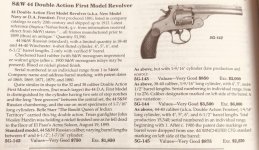superdave269
Member
- Joined
- May 9, 2021
- Messages
- 31
- Reaction score
- 35
have a few question regarding an early smith & wesson 44 double action first model re
I am seeking information on this early 44 DA 1st model. This is my buddy's gun. His father bought it a long time ago. He does have the correct grips for it. His Dad put on the fancy ones.
1st question, since it's two tone are the top release, trigger guard supposed to be blue? The hammer & trigger are case colored.
2nd question, whats the deal with the set screw on the grip frame? Is it there to adjust the trigger pull? If so what the correct way to do that?
3rd and most important question for now, He has a box of 44 Russian ammo for it. I told him in no way shoot that ammo. Since this gun was made in the 1880s it was a black powder gun. I would like to dump the powder and use smokeless but need data to do it safely. Any idea of a safe load? Originally it looks like they were loaded with 23 grns of powder. I found a post that stated "Phil Sharpe's 1937 reloading handbook for the .44 Russian recommends 3.0 grains of Bullseye for the 205-grain bullet, and 5.5 grains of Bullseye for the 246-grain bullet." That seams a bit hot to me. What do you think?
Thanks
I am seeking information on this early 44 DA 1st model. This is my buddy's gun. His father bought it a long time ago. He does have the correct grips for it. His Dad put on the fancy ones.
1st question, since it's two tone are the top release, trigger guard supposed to be blue? The hammer & trigger are case colored.
2nd question, whats the deal with the set screw on the grip frame? Is it there to adjust the trigger pull? If so what the correct way to do that?
3rd and most important question for now, He has a box of 44 Russian ammo for it. I told him in no way shoot that ammo. Since this gun was made in the 1880s it was a black powder gun. I would like to dump the powder and use smokeless but need data to do it safely. Any idea of a safe load? Originally it looks like they were loaded with 23 grns of powder. I found a post that stated "Phil Sharpe's 1937 reloading handbook for the .44 Russian recommends 3.0 grains of Bullseye for the 205-grain bullet, and 5.5 grains of Bullseye for the 246-grain bullet." That seams a bit hot to me. What do you think?
Thanks






